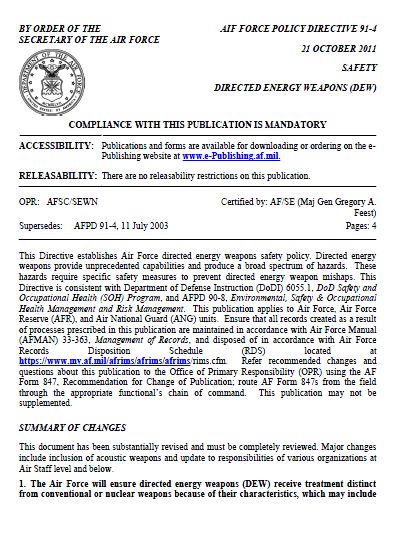This recent revision to U.S. Air Force safety policy on the use of directed energy weapons was first noted by Secrecy News.
AIF FORCE POLICY DIRECTIVE 91-4 DIRECTED ENERGY WEAPONS (DEW)
- 4 pages
- October 21, 2011
1. The Air Force will ensure directed energy weapons (DEW) receive treatment distinct from conventional or nuclear weapons because of their characteristics, which may include speed-of-light delivery, range, and varied weapons effects. DEW require a scalable approach to safety that is commensurate with the hazard potential of each weapon.
1.1. A DEW is a system using a beam of concentrated electromagnetic energy (including but not limited to lasers and high power microwave systems), or atomic or subatomic particles primarily as a direct means to kill, injure, disable, or temporarily incapacitate people or destroy, damage or temporarily incapacitate property or materiel.
1.2. Acoustic weapons use sound across the entire frequency spectrum to kill, injure, disable, or temporarily incapacitate people. Acoustic weapons, although outside the Joint definition of DEW, have effects and hazards more similar to DEW than to conventional weapons. Acoustic weapons will follow the same safety policy as DEW.
2. The Air Force will ensure protection of personnel, property, operational capability and the environment from undue risk of damage or harm from DEW, consistent with mission requirements.
3. The Air Force will establish and conduct a safety program for DEW to ensure the safe research, development, testing, operation, training, maintenance, storage, decommissioning, and disposal of these systems. As an element of this program, the Air Force will determine the applicability of federal, state and local laws and regulations, international law and host nation laws, as well as the utility of advisory standards developed or adopted by national or international scientific safety organizations.
4. The Air Force will establish and conduct a safety certification process for DEW. DEW must be certified as safe prior to operational or training use by AF personnel.
5. The Air Force will investigate mishaps involving DEW in accordance with AFI 91-204, Safety Investigation and Reports, and other directives as appropriate.
6. This directive establishes the following responsibilities and authorities:
6.1. The Assistant Secretary of the Air Force for Installations, Environment and Logistics (SAF/IE) is responsible for safety and occupational health policy for DEW.
6.2. The Assistant Secretary of the Air Force for Acquisition (SAF/AQ) is responsible for ensuring awareness of DEW safety requirements in acquisition policy. SAF/AQ will ensure DEW program managers evaluate effects of DEW on human targets.
6.3. The Air Force Chief of Safety (AF/SE) is responsible for developing directed energy weapons safety policy and procedural guidance. AF/SE is responsible for ensuring compliance with safety policy and for developing and maintaining instructions to implement this directive, and is the certification authority for DEW safety. AF/SE is responsible to determine the utility of advisory standards developed or adopted by national or international scientific safety organizations. AF/SE is responsible for establishing DEW testing and employment proximity restrictions pertaining to nuclear and conventional weapons.
6.4. The Air Force Surgeon General (AF/SG) is responsible for evaluating, recommending controls, diagnosis and treatment of exposure to directed energy weapons.
6.5. At an early stage of the acquisition process, or a modification of an existing weapon, The Judge Advocate General (AF/JA), or the General Counsel (SAF/GC) for a weapon developed within a Special Access Program, will ensure that a weapon legal review is completed for all DEW and that any such weapon complies with domestic and international law.
6.6. The Deputy Chief of Staff for Operations, Plans and Requirements (AF/A3/5) is responsible for ensuring DEW safety requirements are implemented in range operations policy.
6.7. Each MAJCOM utilizing directed energy weapons is responsible for advocating funding requirements and manpower in the budgeting process to ensure sufficient funding and manpower are available to develop and implement the requirements of the Directed Energy Weapons Safety Program.
6.8. AFMC/CC is responsible to support development of safe DEW. AFMC/CC is responsible to evaluate the human target effects of DEW. AFMC/CC is responsible for conducting medical and health effects consulting and education and training. AFMC/CC shall establish, administer, and maintain the DoD Electromagnetic Field (EMF) Injury Hotline and Tri-Service Laser Injury Hotline to provide immediate expert medical advice in the event of an injury or suspected injury to DoD personnel from EMF and lasers. AFMC/CC shall establish, administer, and maintain the EMF Overexposure Repository for DoD Components to access, analyze, and use in EMF protection programs.
6.9. AETC/CC is responsible for developing directed energy curricula and providing training to accomplish the requirements of this directive.
6.10. Commanders at all levels with a mission incorporating DEW are responsible for understanding the capabilities and hazards of DEW systems. They will incorporate DEW safety, consistent with applicable test, training or operational requirements, in their mission planning, decisions and operations.
6.10.1. Outside the United States, its territories or possessions, MAJCOM and NAF commanders must be aware of the safe-use requirements of applicable host nation laws and advise subordinate commanders.
6.10.2. Before fielding any DEW, MAJCOM, NAF, and subordinate echelon Commanders will coordinate their proposed concept of employment with their staff judge advocate (SJA) for a legal review to ensure compliance with applicable law.
7. MAJCOMs, field operating agencies, and direct reporting units, if applicable, will not issue instructions that implement this policy directive without AF/SE approval.

